General terms related to spherical mirrors: A mirror with the shape of a portion cut out of a spherical surface or substance is known as a...

General Terms Related to Spherical Mirrors
April 11, 2024
Clock: We use watches to tell the time of the day. A clock is provided with three hands to measure time: an hour hand, a minute hand, and a second hand. A clock has a total of \(12\) divisions of a full measure of angle \({\text{360}}^\circ \). The angle formed in the clock is used to calculate the time between any two hands of the clock. This article will discuss clocks, clock diagram, their uses, and how to read time from a clock.
A clock or watch, also known as the analog clock, has moving hands and usually hours marked from \(1\) to \(12\) to show you the time.
Some clocks have Roman Numerals \((I, II, III)\) etc. instead, or no numbers at all! Some clocks have numbers \(1, 2, 3, 4, …\) Some clocks are digital clocks, whereas some clocks are analog clocks.
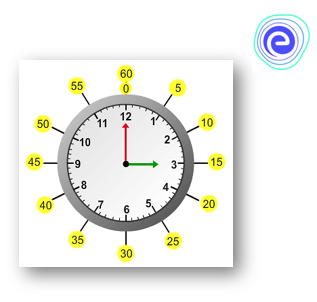
The parts of a clock are as shown below:
We come across different designs of clocks around us. As you know, there are \(1\) to \(12\) numbers on the clock. The clock shows the multiplication table of five on it. Every number is five minutes distant from each other. There are a few of the standard design clocks that are shown below:
The given clock has regular numbers on it from \(1\) to \(12\).
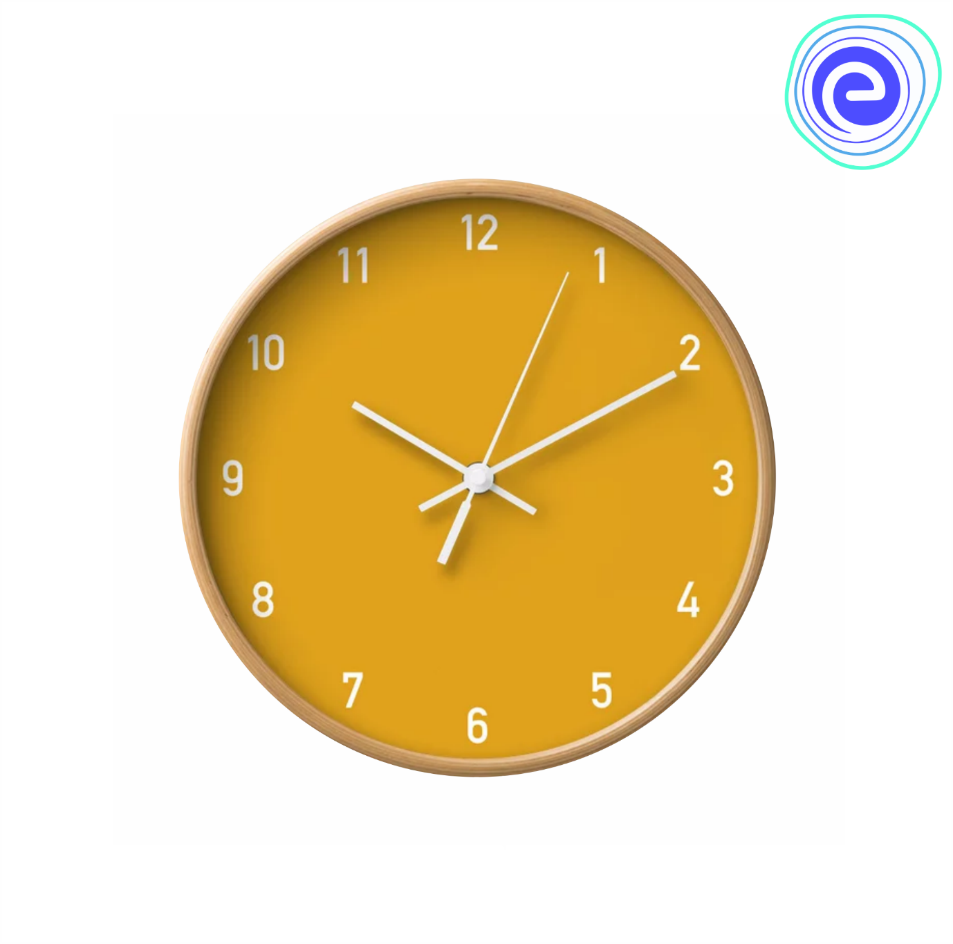
The given clock below has Roman numerals on it from \(I\) to \(XII\).
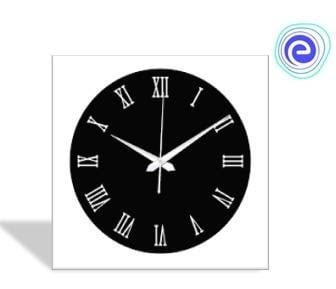
The given clock has no numbers displayed on it.
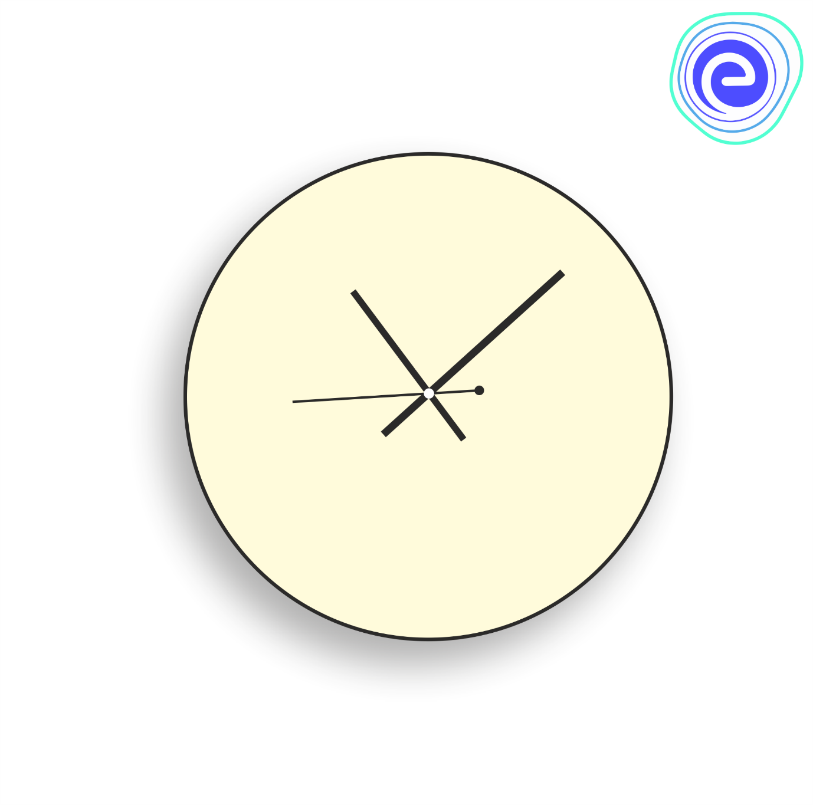
The given clock has only the numbers \(12, 3, 6, 9\) displayed on it.
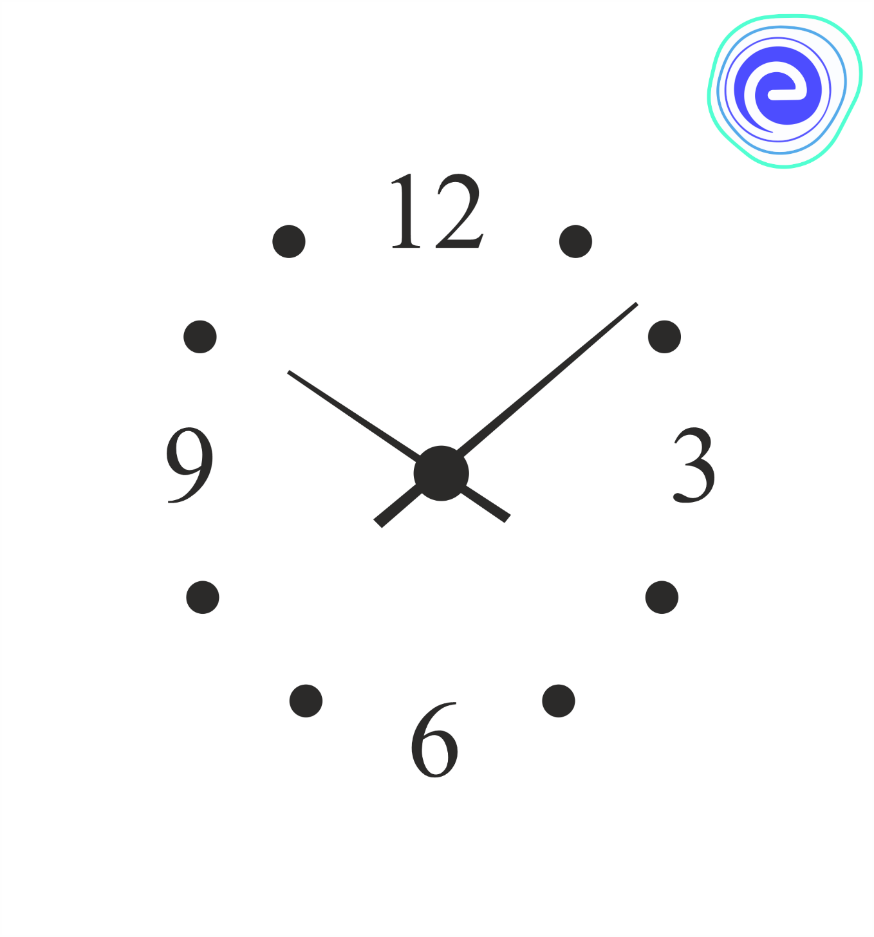
We have three hands on the clock, and the largest unit of time is an hour. A day has \(24\) hours whereas a clock has numbers only from \(1\) to \(12\) written on it. This indicates that there will be two rounds of \(12\) hours in a day.
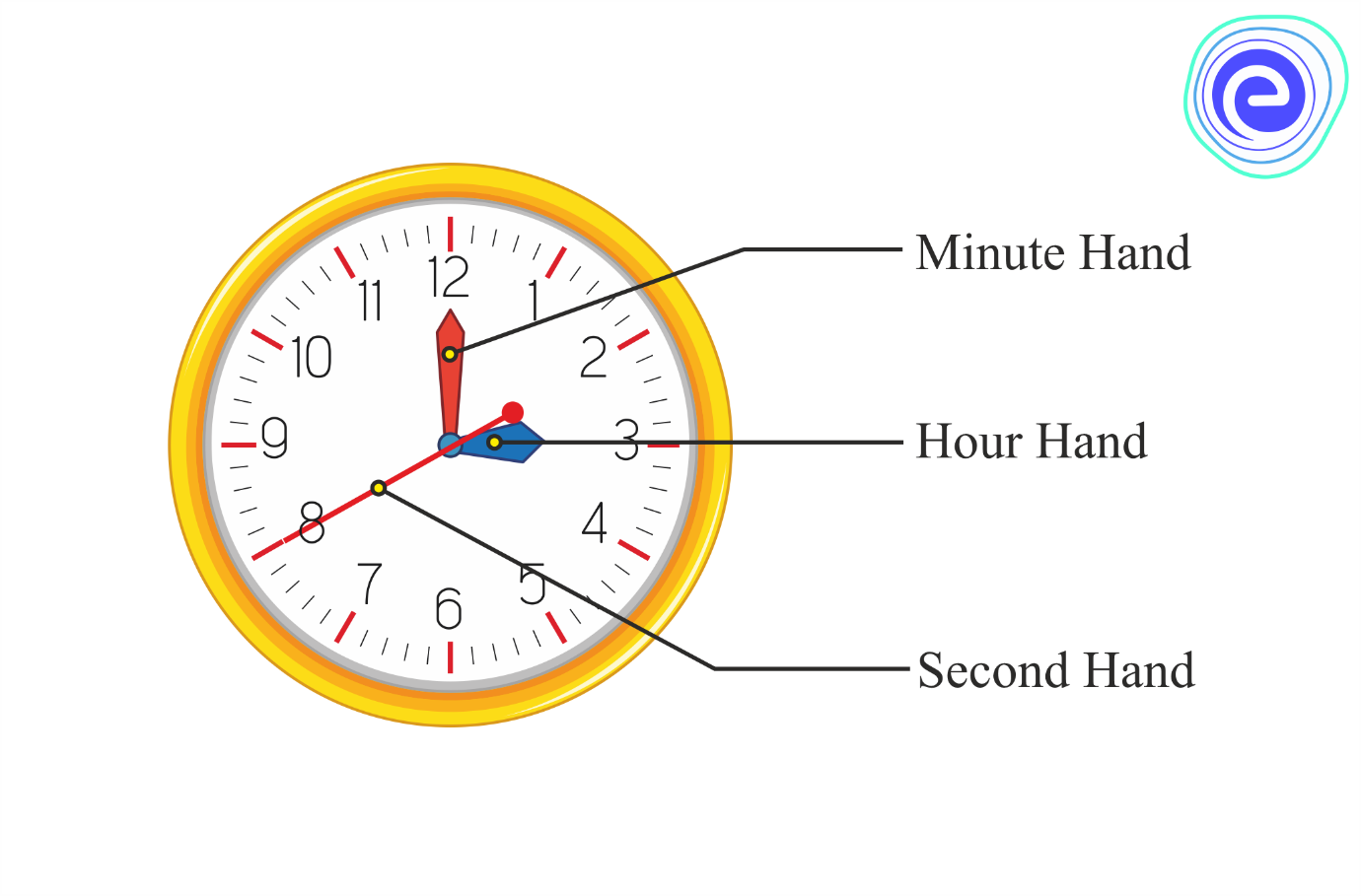
You can see on the clock that there are \(12\) sections. Each of the numbers represents an hour. There are three hands. The longer hand is the minute hand, the shorter hand is the hour hand, and the thin longhand is the seconds hand. Each indicator points to a number, and the combination of the hour, minute, and seconds hand together tells us the time.
Short Hand or Hour Hand: The small needle representing the hour is known as the shorthand or hour hand.
Longer Hand or Minute hand: The long needle representing the minutes is known as the minute hand or longhand.
Seconds hand: The long and thin needle which represents the seconds is known as the second’s hand.
As you know, clocks are helpful for us in many ways, as given below:
1. A watch is a device used to measure, verify, keep, and indicate the time.
2. A clock is one of the oldest human inventions, which meets the need to measure shorter time intervals than the natural units like the day, the lunar month, and the year.
3. Such operating devices on several physical processes have been used over the millennia.
Clocks help us manage our lives. We depend on the watch for our routine activities, from waking up in the morning to sleeping at night. It helps to be everywhere on time, such as arriving at work, leaving work, attending meeting, catching up with friends, or any social commitments. It is essential to be at the right place at the right time to get success in your life.
As you know that time plays a very vital role in our daily life. It is very precious and essential for everyone, and our lives move around time; we live our lives according to the time.
If you want to compete with today’s world to become successful, it is crucial to know the influence of time on our lives. To value the time, you should be on time, and you need a wall clock around you. It is nearly impossible to find any home or business without a watch. Can you imagine your life without a wall clock? I guess the answer will be no way!
We have \(12\) divisions on the clock. The distance between the two divisions is \({\text{30}}^\circ \). Each division is further divided into five equal parts, and each of the parts equals \(1\) minute and has an angular distance of \({\text{6}}^\circ \). You can see the list of features and the corresponding angles below:
| Minutes | Angular Values |
| \(1\) minute | \(6^\circ \) |
| \(2\) minutes | \(12^\circ \) |
| \(3\) minutes | \(18^\circ \) |
| \(4\) minutes | \(24^\circ \) |
| \(5\) minutes | \(30^\circ \) |
| \(6\) minutes | \(36^\circ \) |
| \(7\) minutes | \(42^\circ \) |
| \(8\) minutes | \(48^\circ \) |
| \(9\) minutes | \(54^\circ \) |
| \(10\) minutes | \(60^\circ \) |
Q.1. Kia wants to set the time as \(4:35\) in his clock at home. At what number the minute hand should point.
Ans: Kia wants the minutes as \(35\).
We know that every jump on the clock is \(5\) minutes when the minute hands move from one number to another.
So, \(35÷5=7\)
Hence, the minute hand should point to the number \(7\).
Q.2. Find the clockwise angle between the hour hand and minute hand at \(3:30 \,\text {p.m.}\)
Ans: We need to find the angle between the hour hand and minute hand.
Divisions between the hour hand and minute hand at \(3:30 \,\text {p.m.}\) is \(3\).
Using the clock angle formula, we get, the angle between any two divisions is \(30^\circ \).
Therefore, the angle will be \(3 \times 30^\circ = 90^\circ \).
Hence, the required answer is \(90^\circ \).
Q.3. Find the clockwise angle between the minute hand and the hour hand at \(12.55\,\text {a.m.}\)
Ans: We need to find the angle between the hour hand and minute hand.
Divisions between the hour hand and minute hand at \(12.55\,\text {a.m.}\) is \(11\).
Using the clock angle formula, we get the angle between any two divisions is \(30^{\circ}\).
Therefore, the angle will be \(11 \times 30^{\circ}=330^{\circ}\).
Hence, the required answer is \(330^{\circ}\).
Q.4. If the clock shows \(4:00\,\text {p.m.}\), what is the measured angle made between an hour hand and a minute hand?
Ans: Angle between the hour hand and minute hand.
At \(4:00\,\text {p.m.}\), the minute hand of the clock is on the number \(12\), and the hour hand is on the \(4\)
The angle formed is \(4 \times 30^{\circ}=120^{\circ}\)
Hence, the required answer is \(120^{\circ}\).
Q.5. If the clock shows \(6:00\,\text {p.m.}\), what is the measured angle made between an hour hand and a minute hand?
Ans: Angle between the hour hand and minute hand.
At \(6:00\,\text {p.m.}\), the clock’s minute hand is on the number \(12\), and the hour hand is on the \(6\)
The angle formed is \(6 \times 30^{\circ}=180^{\circ}\)
Hence, the required answer is \(180^{\circ}\).
In this article, we have discussed the clock, then what are the parts of the clock means. Then we talked about numbers in the watch, followed by types of hands like shorthand, seconds hand and longhand. Finally, we glanced at the different uses of clocks, including the importance of the clock and then we have given solved examples and a few FAQs.
Q.1. How do you solve problems with a clock?
Ans: You can see the given below problem to understand how to solve the problem with the clock:
Example: We need to find the angle between the hour hand and minute hand.
Divisions between the hour hand and minute hand at \(12: 55 \,\text {p.m.}\) is \(11\).
Using the clock angle formula, we get, the angle between any two divisions is \(30^{\circ}\).
Therefore, the angle will be \(11 \times 30^{\circ}=330^{\circ}\).
Hence, the required answer is \(330^{\circ}\).
Q.2. What is clock reasoning?
Ans: The clock is an instrument that is used for indicating and maintaining time. This is an electronic device that shows an hour, minute and seconds. The different types of clock reasoning are angle based clock, the reflection of the clock, and defective clock.
Q.3. What is the \(24\)-hour clock?
Ans: You know that there are two types of clocks: a \(12\) – hour clock and a \(24\) – hour clock. The tie from midnight to noon is expressed as \(\text {a.m.}\), while noon to midnight is expressed as \(\text {p.m.}\)
The format of a \(24\) – hour clock is hours : minutes or minutes: seconds, starting from \(00.00\) (mid-night) to \(12:00\) (noon) to \(13:00\) \((1 \,\text {p.m.})\), going upto \(11:59\) at night and then again converting to \(00:00\) (mid-night).
Q.4. What is an atomic clock?
Ans: An atomic clock is the precision clock that depends on an electrical oscillator’s operation regulated by the natural vibration frequencies of an atomic system. Example: the beam of caesium atoms.
Q.5. What is a digital clock?
Ans: Digital clock is the clock that displays the time in numerical digits rather than the hands on the dial.